6 June 1944. Nearly 7,000 vessels containing 132,000 ground troops cross the English Channel to take part in the Allied invasion of western Europe: the largest naval, air and land operation in history. Nothing less than the liberation of a brutally suppressed continent is at stake and after years of intense planning, failure is not an option.
Five assault beaches on the Normandy coast must be taken, including one primarily reserved for Canadian forces: Juno Beach. However, in the vanguard of this sector is a 20-year-old British member of the RAF Beach Squadrons. Sitting in the cab of his truck and laden with supplies, the young driver is launched from his landing craft into deep water. The water rises almost to his chest but after putting his foot down on the accelerator, the engine roars into action and the vehicle lurches onto the beach.
Leading Aircraftman David Teacher was one of the first men to land on Juno Beach on D-Day and spent months afterwards in the same location ensuring that the logistical support for the Allies in France remained strong. His war continued to be dramatic beyond Normandy and as the march east continued, Teacher found himself fighting among American troops at Bastogne during the Battle of the Bulge before taking part in the invasion of Germany in 1945. As we approach the 75th anniversary of the Normandy landings, Teacher’s story is a poignant tale of a young man’s journey through war-torn Europe and the courage and horror that he witnessed.
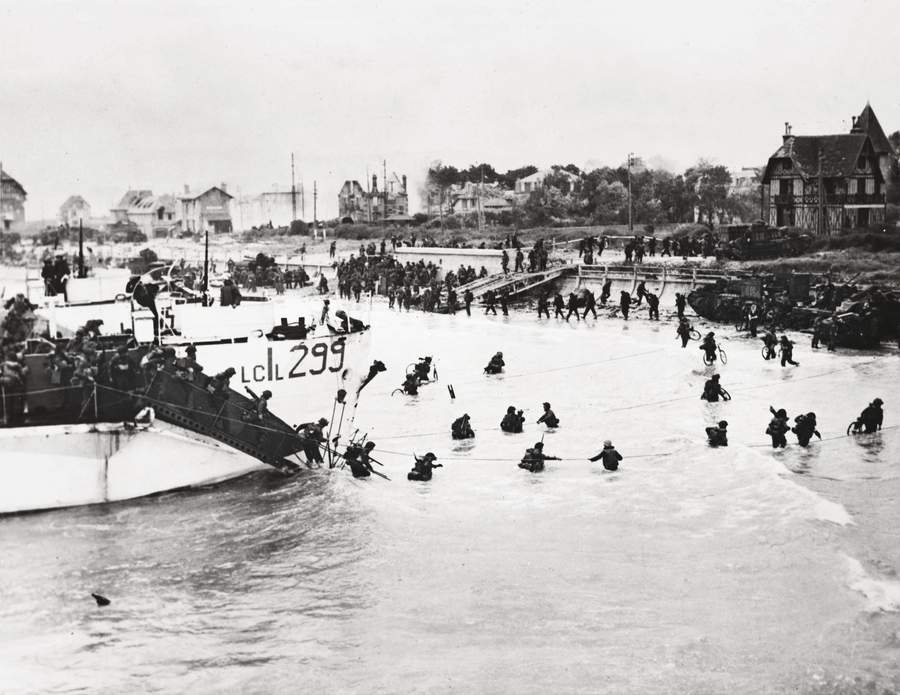
Playing ‘soldiers’ in Palestine
Born into a Jewish family on 29 December 1923 in Hastings, Teacher moved to what was then the British Mandate of Palestine to live with his grandparents in 1934. Living in the small community of Karkur, Teacher experienced a multicultural environment that was nevertheless characterised by tensions the British authorities spent much time attempting to resolve.
It was in Karkur that Teacher first encountered British armed forces: “Due to the circumstances in Palestine, as it was then, there were often riots between the Jewish people and the Arab people and the British police were very much involved. They had a station just outside Karkur where I was living, and eventually the Royal Ulster Rifles had a presence there and were given quite a large camp.”
Far from viewing them as an occupying force, Teacher keenly interacted with the army: “I was there nearly every day of the week, going out on patrols and drinking beer with them. I learned to drive and and learned swear with them! I was 10 years of age and really had a ball enjoying myself. I also used to translate Hebrew and Arabic for them. I got into quite a lot of trouble with my grandparents.”
Teacher moved back to England in 1938 and by the time war broke out in September 1939, he was living in Manchester and working as a mechanic. Having lived through the Manchester Blitz of 1940, Teacher was determined to join the war effort and signed on as an air cadet in order to later join the Royal Air Force. However, he recalls that his reasons for joining the RAF were unclear: “I don’t really know why. I never wanted to fly but it was possibly the uniform. I didn’t fancy the army that was for sure and the navy was impossible to join or very difficult. So I was left with the air force and I was pleased I did, I had a wonderful time.”
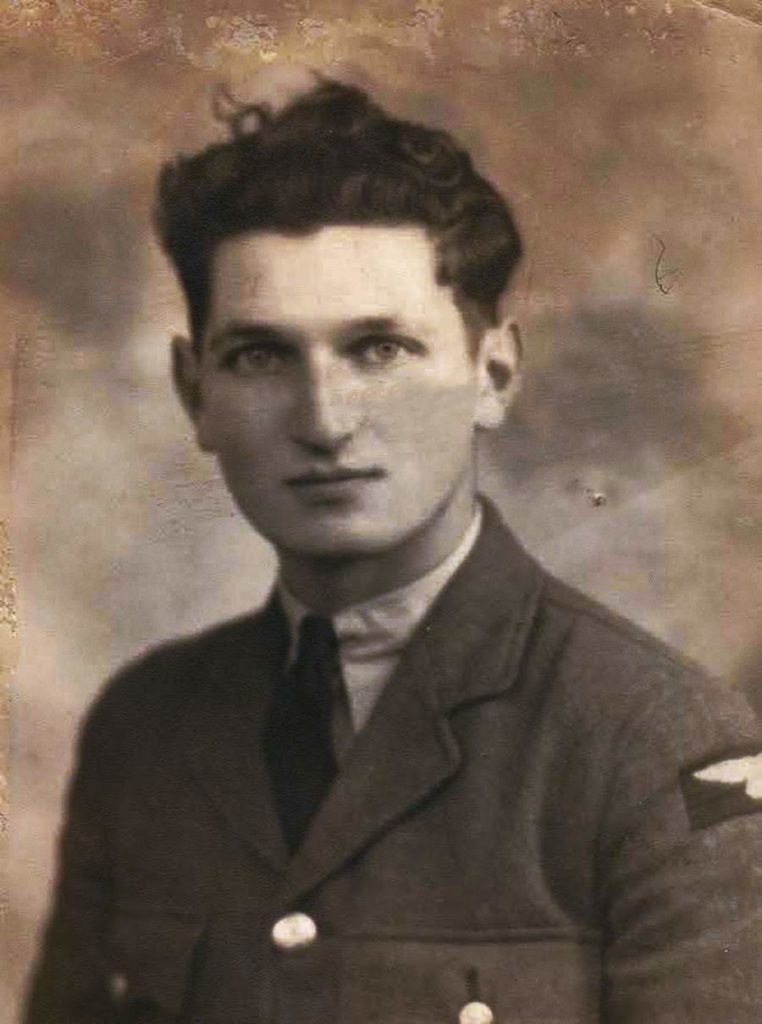
Training, the king and ‘Monty’
Having been officially called up to serve in the British armed forces in September 1942, Teacher was assigned to the RAF and trained as a motor mechanic. By 1943 he was serving in Devon as part of Coastal Command but then volunteered to join a new outfit called Combined Operations. These units were specifically formed as part of the plans for the Allied invasion of Europe.
As Teacher describes: “It was a way of getting the sea services to work together, instead of working against one another, or not being available when we wanted to make certain trials. So as a combined operation, we were always available to do whatever trials or manoeuvres the hierarchy want: that was the start of the preparations for D-Day.”
Teacher would specifically be part of the RAF Beach Squadrons, which were an important element of the 2nd Tactical Air Force. For D-Day, the RAF had to provide close air support and fighter cover for the ground forces in the spearhead of the invasion. Aircraft had to be directed from the ground close to the front line and in order to provide that support, men and material were needed on the ground from the start. The role of the beach squadrons was to come ashore and establish themselves in designated areas to help with the large quantity of fuel, ammunition, equipment and vehicles that was needed to sustain the RAF in the weeks after D-Day.
Training for this complex and crucial operation was intense: “We were 100 per cent fit and then we used to practise a great deal of landings on all different types of surfaces: sands, grass verges etc. This was general training for the invasion. We did a lot of unarmed combat because we were carrying a lot of gear – food, ammunition, petrol, and water – so we weren’t able to carry any armaments. We weren’t allowed to carry revolvers, so we would have had to carry Sten guns or rifles, which was impossible because of all the equipment we’d be carrying from the landing craft.”
As part of No.2 RAF Beach Squadron, Teacher was the main mechanic and serviced various vehicles such as Jeeps, motorcycles and trucks. The latter would feature most prominently in Teacher’s war experience particularly when the unit took possession of Bedford QL trucks, a vehicle he describes as “very reliable, I never had any trouble with it in all the 18 months that we had them.” Teacher would experience D-Day driving a Bedford and during the preparations for the invasion he spent much time practising waterproofing his and others vehicles for a beach landing.

Because of the importance of the training involved, Teacher came into contact with two of the most famous British figures of WWII: Field Marshal Bernard Montgomery and King George VI. On 25 April 1944 the latter inspected a large parade of over 5,000 troops at Hiltingbury Camp. Most of the men were Canadian with some British Army units and all were wearing khaki uniforms with the exception of Teacher’s RAF unit. He recalls: “I remember King George VI particularly. We were training for some 12 months with the command and were just in khaki, when all of a sudden someone from air force hierarchy came down and said, “These lads have got to be dressed in blue.” There was a big argument going on and he said “I’m very sorry but they are Royal Air Force, and RAF uniform is blue, so they will wear blue end of story.” So we were issued with brand-new kit and it was about this time that the king came and inspected us all. We (about a group of 30 men) stood out like a sore finger, so the king wanted to know what this bit of blue was doing among all the khaki. He drove over in his Jeep and dismounted. We opened ranks and he inspected each one of us. We were highly delighted because it was one up for the RAF on the army! It was fabulous.”
By contrast, Teacher’s memories of Montgomery, the commander of all Allied ground forces for the invasion, were mixed: “He was a very moody man, one day he would be very sociable, another he wouldn’t speak to anybody. He was always encouraging us and very optimistic that everything would go well. He was right at the end of the day but he made a lot of mistakes. He wouldn’t listen to advice, he was always right and he always did what he wanted to do.”

By the summer all preparations were complete for ‘Operation Overlord’ and Teacher drove his Bedford truck to Southampton on 5 June 1944. His was the last of three Bedford trucks (and the only one belonging to the RAF) to reverse onto a landing craft, which meant that he would be first off when it landed for the invasion. However, despite months of training and speculation Teacher didn’t know what his destination would be: “We had no idea where we were landing, not even when we got there. We weren’t told anything. I was waiting in a landing craft for about four hours before we went ashore and the coxswain wouldn’t say where we were. I don’t even know if he knew, certainly he wouldn’t tell me if he did.”
D-Day
Amidst a choppy sea on 6 June 1944, Teacher sat on top of a truck and observed the vast armada he was part of: “It was unbelievable. You could not realise what was going on. There were thousands of ships and landing craft, battleships, destroyers, aircraft flying overhead… the noise was unbelievable. When the navy started bombarding a couple of hours before we went ashore, it was horrendous.”
As the flotilla made its way south, Teacher remembers wanting to start what he had trained for months to do: “I just wanted to get on with it. I was just keen to get ashore and get started. We’d been trained repeatedly and now it was a case of putting it all into practice and seeing how well it went. As it happens it went very well indeed. The weather caused more damage than the enemy.”
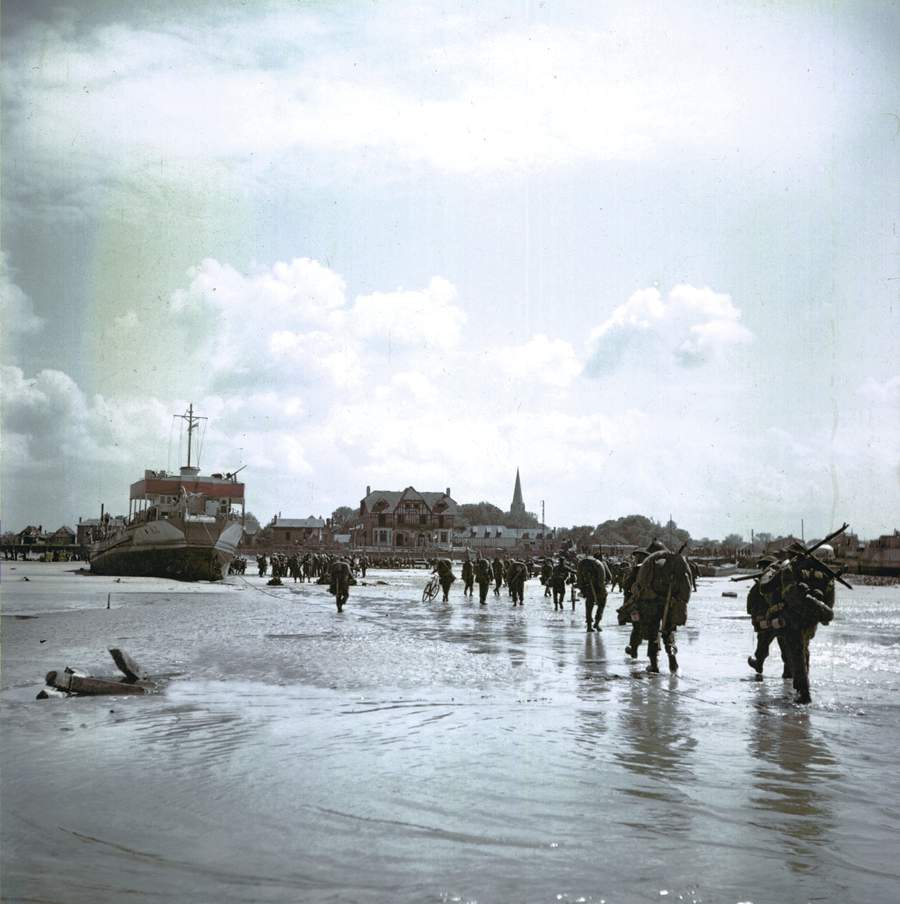
The official orders for the Beach Squadrons on D-Day were as follows: “Nos. 1, 2 and 4 RAF Beach Squadrons will work with the Army Beach Organisation to supervise the discharge of RAF personnel, vehicles and stores, and movement to the forward area of all units.” The ‘discharge’ area for Teacher would be on Juno Beach.
Juno formed part of five Allied assault beaches along the Normandy coast. Two of these beaches, Omaha and Utah, were to be taken by the Americans, with the Commonwealth forces set to secure the remaining three. The Commonwealth beaches were codenamed after fish: Gold (fish), Sword (fish) and Jelly (fish). In the latter’s case it was rumoured that Winston Churchill crossed out ‘Jelly’ and replaced it with the word ‘Juno’ after the Roman goddess.
The beach was a 10-kilometre stretch of coast centred around the small fishing village of Courseulles-sur-Mer and split into three sectors known as ‘Love’, ‘Mike’ and ‘Nan’. Unlike Gold and Sword beaches, which were primarily assaulted by the British, Juno was in the hands of the Canadian 3rd Division. Their task would be to link up with Gold to the west and Sword to the east. Nevertheless, before the bulk of the Canadians could land, the beach units – including Teacher’s – had to disembark and establish themselves.
Teacher vividly remembers the dicey start to his own landing in ‘Mike’ sector at 8.20am on 6 June: “I was one of the first to shore. It was very noisy, but the coxswain said, “I’m sorry Dave, but I’m going to have to drop you in deep water.” I said “How deep?” He said, “I’m afraid to say very deep. Come on, let’s get going” and he dropped the front part of the landing craft. I went into the sea and went down and down. It actually stopped sinking when the water was up to my chest. So I put it in gear, 4-wheel drive, and drove it to shore without any problems at all.”
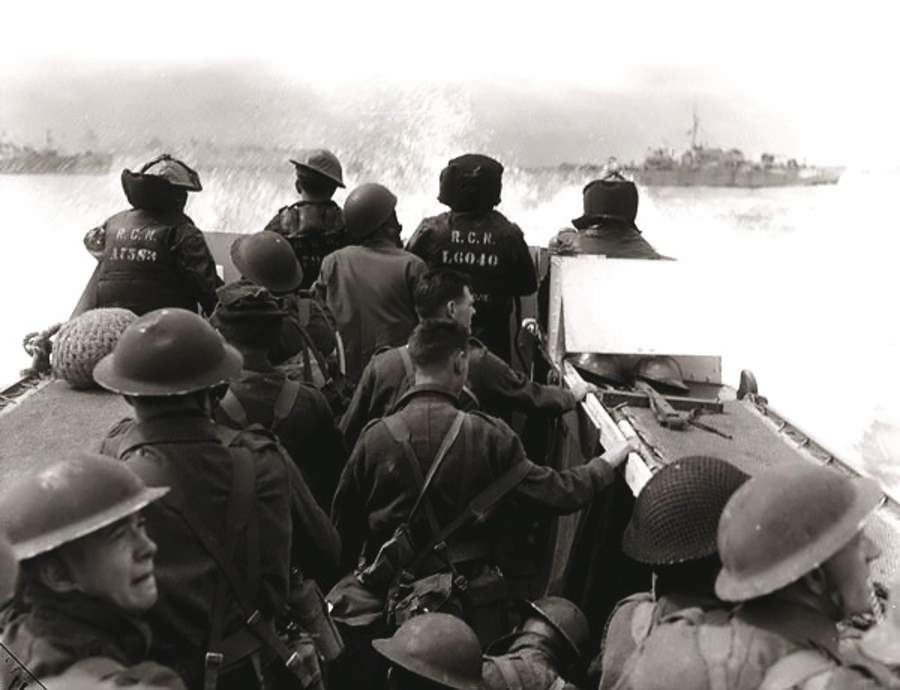
Once he had landed, Teacher drove to a sandy clearing known as a ‘DVP’ (Drowned Vehicle Park) where all broken down vehicles were to be stored. He left his Bedford there and returned to the beach: “Our job was to take in all the equipment, the food, ammunition – anything that was required to serve the army. So we were in control of the equipment that came through Juno Beach. We also had to make sure that all the troops that came ashore didn’t run amok, but went through the safe areas that had been taped off. It was very well organised. It wasn’t like in films where they dash off these landing craft and run. It was very well organised – they did not run amok. Obviously there were those who got injured, but generally speaking it went very well.”
As a mechanic Teacher would also fix broken down vehicles and move them on as quickly as possible. Nevertheless he was under fire from the Germans who counterattacked using 88mm guns and aerial bombardment. Teacher witnessed landing craft being thrown in the air and survived an unexploded bomb that landed 6 metres away from him. Less than half a mile away from his position there was close quarter fighting with bayonets.
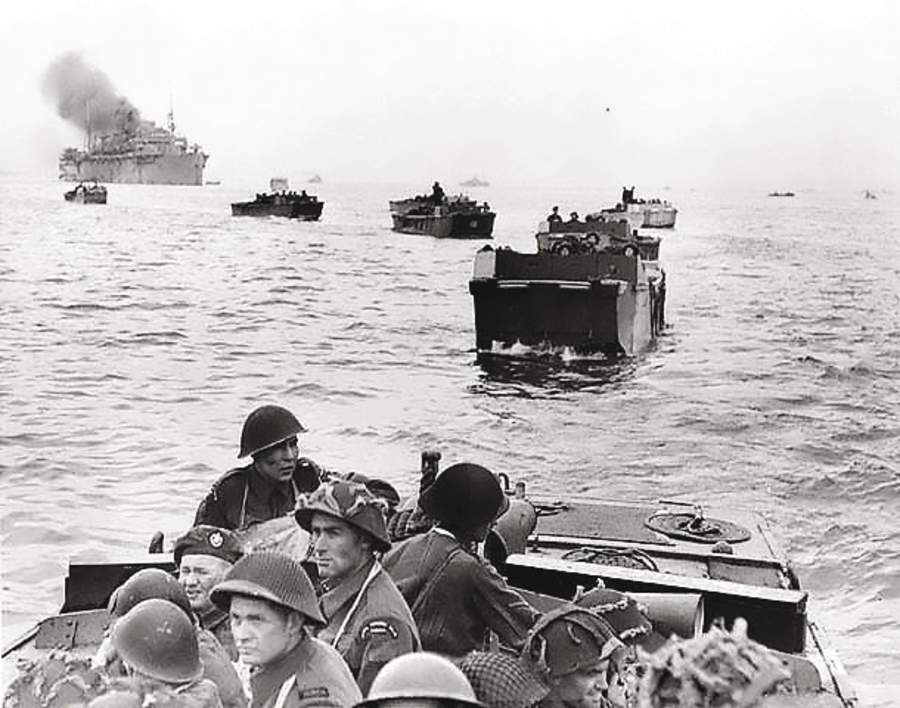
This intense scenario was Teacher’s first experience of combat but his thorough training served him well: “You revert back to your training and you do what you were told to do. We were very well trained and we kept to the training moves and migrations and got through. In fact it went very easily. At around 4pm the Germans tried to attack, without any success. We had a couple of casualties then, but they were our only battlefield casualties of the campaign.” This particular German attack was a heavy air bombardment with anti-personnel bombs in the beach maintenance area.
By the end of 6 June, 21,400 Allied soldiers had landed on Juno Beach but 1,200 had become casualties. Such was the German firepower it is estimated that in the first assaults each Canadian soldier had a 50-50 chance of survival. Nevertheless by the end of the day the Canadians had cleared exits off the beach and linked up with the British at Gold Beach. Teacher remembers them as, “Excellent lads. They were all young boys but very high-spirited, eager and very nice to get on with.”
The RAF’s own ground statistics for Juno on D-Day were impressive: 657 RAF personnel disembarked along with 75 tonnes of stores and 146 M T vehicles were landed. However, Teacher would not leave the area for months: “We weren’t allowed off the beach. For three months we just took equipment in, food, ammunition, hospital equipment and anything that was needed for the army to run efficiently. All the wounded came back to our beaches, we sent them back home on landing craft.”
Teacher remained on Juno Beach from 6 June until it was closed on 6 September 1944. The unit was shelled almost every day as the Germans could fire with 88mm guns from miles away. There were also continual problems with flies that were attracted to dead bodies. To compound matters, Teacher was constrained by censorship: “It was still very secretive. We had no leave, you couldn’t write letters and everything was heavily censored. We also weren’t allowed any contact with the local population at all. That was it, we just got on with what we had to do.”
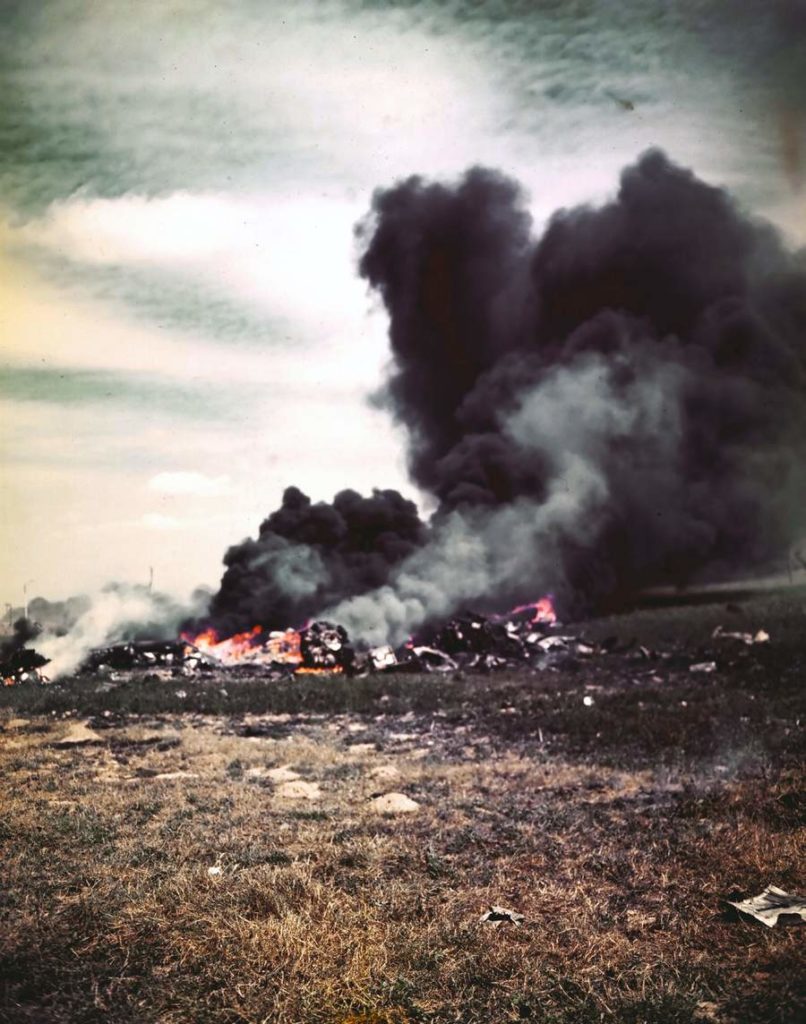
Nevertheless by the time Teacher left Juno, the combined operations units had discharged a total of 20,650 tonnes of stores, disembarked 30,728 personnel and landed 8,644 vehicles. Along with similar impressive feats from the other beaches, there was now no going back and Teacher’s own war in Europe was far from over.
Battle of the Bulge
After a short spell in England, Teacher was transferred to No. 2742 Squadron, RAF Regiment. Initially designed for defensive security purposes, 2742 Squadron was reconfigured to become a reconnaissance unit. Teacher’s job was to maintain and drive the vehicles of the squadron that belonged to ‘A’ flight. These included a Bedford truck, one Jeep and BSA motorcycle, an American Dodge truck and five Humber Super Snipe cars.
Teacher quickly returned to the continent in September and by December he was recovering in a Brussels hospital after a motorcycle accident. The 2742 Squadron was supposed to spend Christmas 1944 in Ghent but only a week after leaving hospital, Teacher’s unit was assigned to work with the US 8th Corps at Bastogne. The Belgian town was close to the Luxembourg border and only 80 kilometres away from German territory. Teacher arrived on 17 December and his sudden deployment was a surprise: “We weren’t told where we were going, and were given 30 minutes’ notice to set off. The weather was terrible, it was just starting to snow and we finished up in the Bulge.” It was unfortunate timing as the Battle of the Bulge had just begun.

This huge battle was the last major German offensive campaign in western Europe and Hitler’s last gamble to halt the Allied advance. The overall plan was to drive a wedge through Allied forces, break them in two and recapture the port of Antwerp. In an eerie repeat of the Battle of France, the Germans completely surprised thinly defended Allied lines in the Ardennes forest and the resulting advance made a literal ‘bulge’ on military maps. Half a million German soldiers, including 13 infantry divisions and seven armoured divisions, were aided by poor weather conditions that prevented Allied air attacks from assisting the beleaguered troops on the ground. The vast majority of Allied troops in the Ardennes were American but around 55,000 troops serving in the British armed forces, including Teacher, also fought in the battle.
Bastogne was an important strategic crossroads in the Ardennes and approximately 11,000 American troops quickly became besieged by around 54,000 German soldiers from 20 December. 2742 Squadron’s task was to seek out German units and report their position in the area near Bastogne. Teacher was largely positioned around Marche-en-Famenne, 32 kilometres north west of Bastogne from 21 December: “We were near the 101st Airborne Division: we were only yards from them in many places. It’s strange to think what a small world it is!”
Fighting conditions during the battle were notoriously difficult: “We were in or near Bastogne for weeks… it was cold, wet and miserable. We had no food or heat. The snow was six feet deep. The temperature was extremely low and we were in summer uniform. It wasn’t pleasant.”
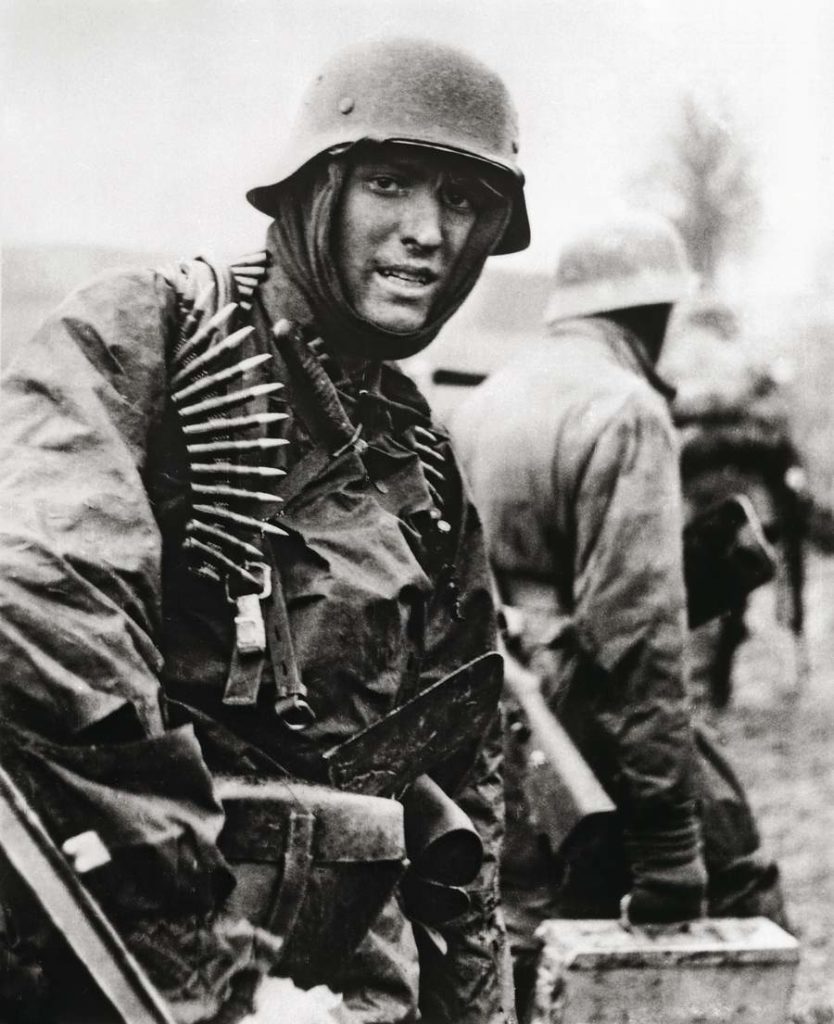
Teacher and the other members of 2742 relied on the Americans to keep the squadron going: “We were depending on the Americans for food and fuel. As I was the driver and mechanic, it was my job to bring up rations and supplies. I saw more of the Yanks than most people did. They were very nice lads, doing a great job under difficult conditions. It was organised chaos. There was no day or night, it was just cold, dark, wet and miserable.”
No fires were permitted during the battle and Teacher still had to run the engines of his vehicles every 15 minutes to prevent the fuel freezing in temperatures as low as -18 degrees Celsius. Nevertheless, despite the conditions Teacher’s diligence did not go unnoticed and it was noted in the squadron’s records: “Vehicle maintenance in these testing conditions has been first class.” Teacher puts it more modestly, “We came out of the battle in late December 1944, early January 1945, after four and a half weeks of fighting. It was a long stretch. We were under constant attack and those four weeks were the worst experience of my service, but we survived.”
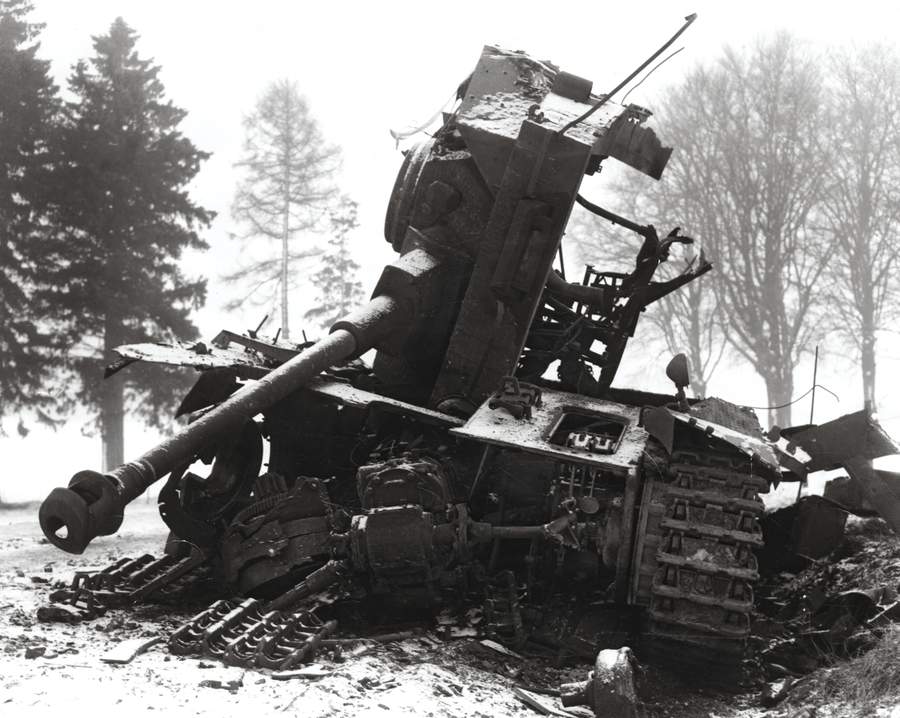
The Invasion of Germany
Bastogne was eventually relieved on 26 December 1944 and Teacher left the battlefield a few days later. After a brief rest in Ghent and Brussels, 2742 Squadron was ordered to prepare for the invasion of Germany. On 15 March 1945 Teacher crossed the River Rhine into Germany: “We were the first RAF ground unit to cross the Rhine but obviously aircraft had been over in the sky beforehand.”

As one of the first RAF units to enter the heart of the Nazi regime, Teacher was understandably nervous: “We were all very concerned. We’d fought the enemy without really seeing them, and we wondered how determined they would be to defend their own Fatherland.” However, he was surprised when armed resistance fell away inside Germany: “As it turns out it was a doddle by comparison to the rest of the war. They did not put up a great fight in Germany itself, they kept surrendering and the biggest problem then was taking prisoners.”
Nevertheless, Teacher was not spared the full horrors of Nazi brutality. When Buchenwald concentration camp was liberated by American forces in April 1945, Supreme Allied Commander Dwight D Eisenhower insisted that all Allied personnel within the vicinity had to go past the camp. Some 250,000 people had been imprisoned at Buchenwald between 1937-45 and although exact mortality figures can only be estimated, at least 56,000 prisoners were murdered, including 11,000 Jews.
When the Americans liberated the camps they found 21,000 emaciated and starved prisoners as well as piles of dead bodies. Eisenhower wanted as many men as possible to see the camp because he believed, “the day will come when some son of a bitch will say this never happened.””
Teacher was one of those ordered to witness the horror and although he is Jewish, he is keen to note that the camp’s victims did not just include Jews: “We went past Buchenwald just after it had been liberated, we were probably one of the first of the general bulk of the army to see what went on. I don’t think it makes a difference being Jewish or not. There were atrocities committed to non-Jewish people as well. Anyone who wasn’t Aryan was rubbish, and treated as such.”
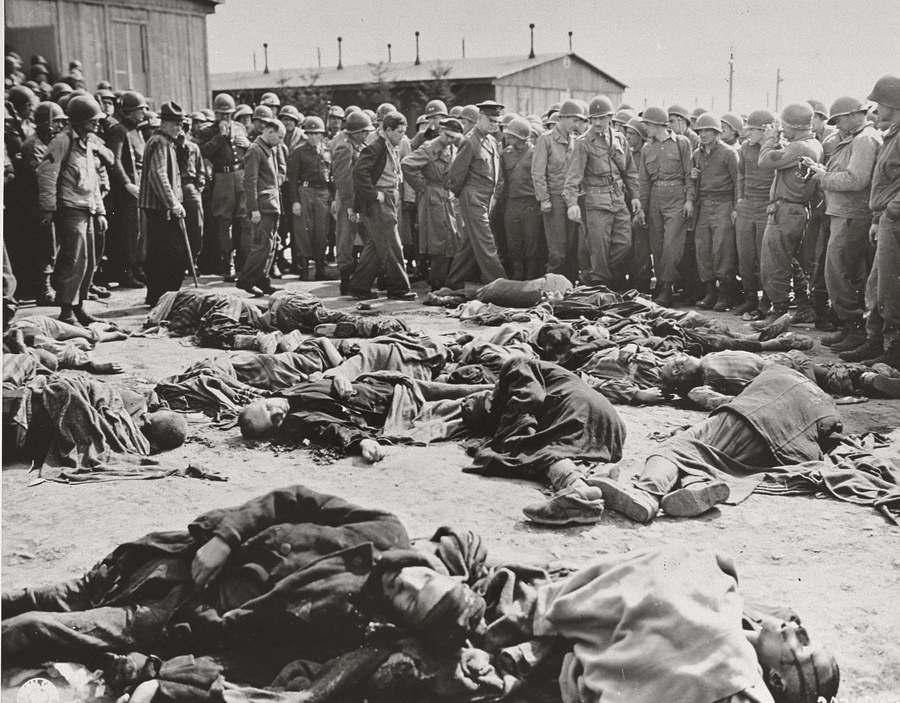
His experience at Buchenwald reinforced his already low opinion of the Germans and the brutalities they inflicted on civilians: “They were a determined lot, but to me the only good German was a dead German. I still don’t have much respect for them. We saw some terrible atrocities that they had committed: burning churches, women and children being tortured and general maltreatment. The thing that upset me was that afterwards they used to run around firing their weapons in the air, it wasn’t nice.”
By VE Day on 8 May, Teacher and the RAF Regiment was approximately 80 kilometres from Berlin and he was relieved that the Russians would take the German capital: “We had no choice. We were told the Russians would get there first, and to be honest we were quite happy about it because of the casualties. The Russians had lost 250,000 men just taking Berlin and those could have been our casualties. So those were lives saved. The Russians were more than happy to do it.”
Having been through so much since D-Day, Teacher (still only 21 years old) was relieved the war had ended: “It was a great relief when the fighting was over. It was inevitable it was going to happen and there was no doubt about how it was going to end, so the sooner it ended the better.” After a short spell back home Teacher was posted to the Azores en route to the Far East but the Japanese surrendered and he was eventually de-mobbed in December 1946.
Recognition
In the years since the war, Teacher has been heavily involved in charity work and was subsequently awarded an MBE for his work with ex-service organisations in Greater Manchester. In 2015 he was also awarded the Légion d’honneur by the French government after President François Hollande officially recognised all surviving British veterans who fought for the liberation of France between 1944-45.
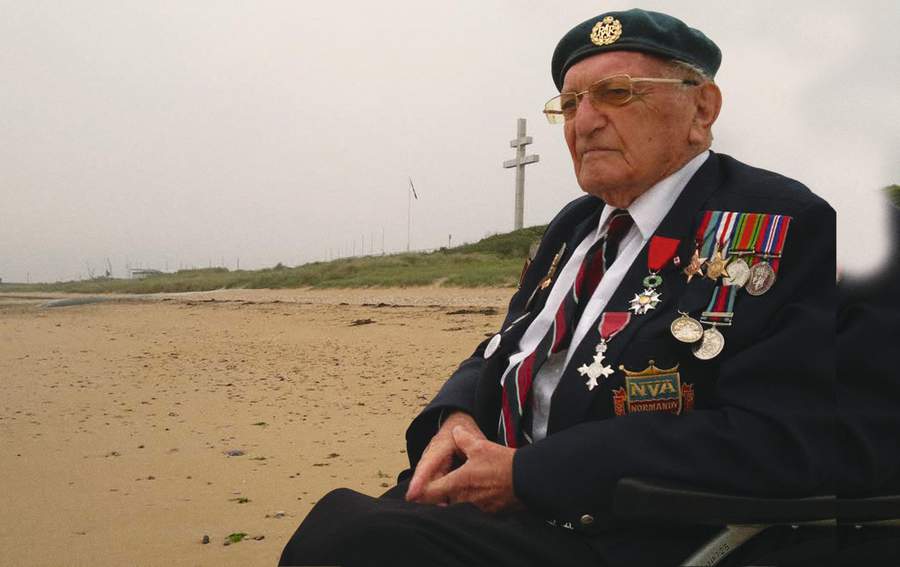
Since 2015, Teacher has volunteered at Imperial War Museum North in Stretford, Manchester and speaks to school parties and adults, averaging around 2,000 people per month. He enjoys hearing the varied and occasionally humorous questions from schoolchildren: “The main thing is about food, “What did you get to eat?” and sometimes I’m asked, “How did you charge your mobile phone?” They are very receptive: some are very knowledgeable and others are curious. I go twice a week to IWM North, its very enjoyable.”
As for his own dramatic experiences during the war, Teacher’s main memories are positive despite the frequently horrific events he endured: “I enjoyed every minute of it. I enjoyed the comradeship including the hardships, because we all went through it together. I enjoyed my service career immensely, its something I would do again if I had to – I wouldn’t hesitate. It was a wonderful way of life, no doubt about it.”

Images courtesy of David Teacher and Future PLC Asset Library.
More D-Day veteran stories will be available in History of War’s upcoming 75th anniversary commemorative Issue 68, which is published on 16 May 2019. To purchase a subscription visit: www.myfavouritemagazines.co.uk